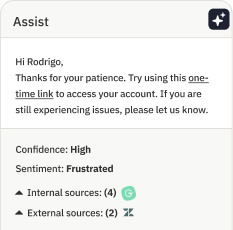What is Time Management?

Have you ever looked back on your day and wondered where all the time went? Or looked at a clock and found yourself shocked? Alternatively, maybe you’ve had days where you finished your work early and struggled to find something to fill in your remaining hours.
What do these scenarios have in common? They’re the result of a lack of effective Time Management. They also represent wasted potential. After all, we only have so many hours in a day and how we use them matters.
That’s what Time Management for support teams is all about—quantifying exactly how effectively a support team (and, as a result, an organization) spends its time. A proper Time Management system provides insight into your team and can transform the experience for your support agents (more visibility into the impact of their efforts!) and your customers (better and faster service from your agents!).
Does this matter to you? Keep reading if…
- You need more visibility into how your agents are spending their days. Are they working when needed? Are they meeting targets?
- Your forecasts tell you that you have enough coverage for the day or week but you still aren’t hitting your performance targets.
- You notice agents spending a lot of time on non-customer facing activities that weren’t in the plan, like internal communications or administrative tasks.
- You want agents to be able to see their hard work paying off, and you know metrics are the best way to do that.
What exactly is Time Management?
First up, it’s important to point out that in a workforce management context, Time Management has a specific meaning that may differ a little from what you might be used to in a more general productivity sense. With that in mind, it’ll be helpful to explain what exactly we mean by “Time Management.”
Here’s the gist: Time Management is a set of metrics that help measure and quantify whether your agents are sticking to the schedule that has been set for them. In official workforce management lingo, time management specifically refers to adherence and conformance:
- Adherence measures how closely agents follow their schedules. In other words, if an agent is scheduled for 100 minutes, and they stick to that schedule for 90 minutes, they have a Schedule Adherence (SA) of 90%.
- Conformance tracks how many total productive hours are delivered by those agents during their scheduled time. For example, if an agent is scheduled to work for 100 minutes and they work for 95 minutes, their Schedule Conformance is 95%.
If you think those two metrics sound the same, don’t worry—you’re not alone. In reality, while they are very similar, there’s a subtle (but key) difference: conformance is concerned with the amount of work an agent does, regardless of when they do it. Adherence, on the other hand, is specifically about ensuring the agent completes their work during their scheduled time.
For even more info about adherence & conformance, watch the spotlight video from our recent webinar below:
For a business to perform at peak effectiveness, there needs to be some degree of stability and predictability around who is doing the work and when. It’s hard to deliver on your service commitments to customers without some idea of what your agents are doing and when they’re doing it.
This is even more true now than ever before. With so much of the world working remotely every day, leaders can no longer peer over the shoulders of their staff to get a literal glimpse into what they’re working on. And honestly? That’s not effective or appropriate for the modern workforce anyway. This is precisely where Time Management comes in.
Time Management vs. Real-Time Management vs. Intraday Schedule Management
Before we continue, let’s take a minute to clarify how Time Management for support teams differs (and complements) two similar Workforce Management tools: Real-Time Management and Intraday Schedule Management.
Real-Time Management focuses on tracking time management as things happen, so teams can move staff around on the fly to best meet demand. The Time Management metrics we’re discussing here are more focused on historical values, which enables you to identify trends that you might have been too busy to catch in real time.
Intraday Schedule Management is the practice of changing schedules proactively throughout a day or week to better balance teams and make time for meetings and other events. Accurate Intraday Scheduling is enabled by effective Time Management practices, and the latter can also help with finding the best times for those meetings and other “off-task” activities.
Walking the (fine) line between Time Management and agent empowerment
Time Management can be a tricky topic in some organizations. There’s a certain tension inherent in the metrics:
- Enabling (and allowing) your agents to work in the way that’s best for them, and…
- Ensuring there’s enough stability and predictability to run the business
The reality is that both of these factors are important, but they also often feel like they’re in competition with one another.
People don’t generally like to be micromanaged, and they’re also not machines—they’ll never be perfect, no matter how good that might be for business (at least on paper). Workers also have more options than ever for flexibility and autonomy, particularly with remote work.
At the same time, the business needs to operate at a certain level, and too much autonomy can be a bad thing, leaving agents rudderless and unsure of what to work on next.
The key is to strike the right balance between these two elements, and that’s where the Time Management metrics can be most useful. In fact, when done right, Time Management actually provides more visibility and recognition to your best agents and helps everybody on the team better understand their own answer to this crucial question: Am I doing a good job?
4 benefits of Time Management
As you might already guess, effective Time Management can have far-reaching impacts on your organization. Here are a few noteworthy advantages:
- Time Management is the simplest method to improve agent productivity in a way that actually impacts your customer experience.
- Time Management enables you to reward your top performers by providing a clear and normalized metric on agent productivity. This is critical in areas where performance is more subjective.
- Time Management can help reduce the total hours needed to hit your response time targets, which can help you save big on hiring costs.
- Time Management adds a critical metric that gives you the ability to debug response time and agent performance issues. This is invaluable for future planning and goal-setting.
How does Time Management actually work?
Now that you know what Time Management is and why it’s important, let’s look at what a healthy process involves. As usual, we’ll start with gathering data.
Step #1: Gather data on current performance
Start off by analyzing your team’s current performance. The data you need can be found in your workforce management software (we’re partial to Assembled, obviously). If you’re not set up with a workforce management solution yet, then that should be your first step.
Convinced you can manage it all in a spreadsheet? Well, step back and think about how many times an agent will log in or out and change availability states in a single day. Now, multiply that by your total support agents. It’s a pretty big number—and one that’s way too cumbersome to deal with in a clunky spreadsheet. That’s why a workforce management solution is the way to go.
As mentioned above, you want to look at when employees are scheduled and compare that to when they’re actually working as well as how much they’re getting done overall (regardless of time spent). It’s also a good idea to look at your other performance metrics, like customer satisfaction, to determine if your team is meeting its targets and how better time management could help.
Consider this scenario: You currently have a very strict adherence policy and require employees to meet this goal. While they do a fairly good job of it, you have received several complaints of gruff and unfriendly support staff and overall morale seems low. Additionally, in your analysis you find that many of the tasks and support tickets that staff are handling can be done on a much more flexible schedule.
In the above situation, it might be beneficial to relax your adherence targets and focus more on conformance—in other words, allow more flexibility in scheduling and work hours as long as productivity remains high. This could very likely result in happier, less-stressed staff, which can then translate directly to better interactions and more satisfied customers.
Step #2: Set reasonable Time Management goals
Now that you have a picture of your current Time Management situation, it’s time to decide where you want to head in the future. That means setting targets for your team.
As you go through this process, it’s important to remember that agents are people—they’re never going to hit perfect 100% adherence or conformance, and in the case of the former it might even be detrimental (see that example above).
Your own goals will be as unique as your support team. But, as a general rule, the industry benchmark for schedule adherence is 85%, while conformance should be as close to 100% as possible.
Step #3: Monitor performance and adjust your goals as necessary
Once your targets are set, you can watch them to see how well staff meet their goals and how the changes impact the business as a whole. From there, you can further refine your goals.
For example, you might decide to relax your adherence target to align more with that 85% industry standard. However, you may find that your particular crew doesn't perform as well with the increased autonomy that comes with it. That’s perfectly fine—some teams just need more structure. So, you can try bumping that percentage up and reevaluate further down the line.
As you go, take time to let your agents know their hard work is appreciated and is helping customers. If you have to make any drastic changes—say, you’ve been lax with adherence requirements and now need to tighten up—be sure to explain why you’re making those changes and how it can benefit not just your customers, but also your team.
It’s also not a bad idea to work with your leadership teams to create incentive programs for meeting targets. This can help encourage buy-in from staff.
Time is your most valuable resource—use it wisely
Time Management metrics provide a powerful tool for monitoring, measuring, and reframing how and when your support team gets work done. Time Management offers a simple way to quantify performance across the board and see where your team is succeeding (or where you need to make some strategic tweaks and improvements).
Keep these tips in mind when putting your Time Management plans together to help get the most out of them:
- With great power comes great responsibility: Time Management should not be a tool used to micromanage your team—instead, it should be a way for you to quantify agent success and empower them to do their best work.
- Reasonable expectations are key: Agents are people, not machines. Keep your targets flexible.
- Everyone likes to see their hard work recognized: Time Management shouldn’t be punitive. You can use Time Management as a way to celebrate milestones and break down how they were reached.
If you’re new to the concepts of Time Management, adherence, and conformance, they can seem dense and daunting. However, they’re actually fairly simple at heart, and if you’ve read this far, you should be in a much better position to measure and implement the concepts.
Don’t let time pass you by—get started today!




